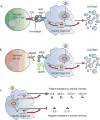Viral miRNAs and immune evasion
- PMID: 21757042
- PMCID: PMC3864029
- DOI: 10.1016/j.bbagrm.2011.06.012
Viral miRNAs and immune evasion
Abstract
Viral miRNAs, ~22nt RNA molecules which post-transcriptionally regulate gene expression, are emerging as important tools in immune evasion. Viral infection is a complex process that requires immune evasion in order to establish persistent life-long infection of the host. During this process viruses express both protein-coding and non-coding genes, which help to modulate the cellular environment making it more favorable for infection. In the last decade, it was uncovered that DNA viruses express a diverse and abundant pool of small non-coding RNA molecules, called microRNAs (miRNAs). These virally encoded miRNAs are non-immunogenic and therefore are important tools used to evade both innate and adaptive immune responses. This review aims to summarize our current knowledge of herpesvirus- and polyomavirus-encoded miRNAs, and how they contribute to immune evasion by targeting viral and/or host cellular genes. This article is part of a Special Issue entitled: MicroRNAs in viral gene regulation.
Copyright © 2011 Elsevier B.V. All rights reserved.
Figures

Similar articles
-
The Diverse Roles of microRNAs at the Host⁻Virus Interface.Viruses. 2018 Aug 19;10(8):440. doi: 10.3390/v10080440. Viruses. 2018. PMID: 30126238 Free PMC article. Review.
-
Viral miRNAs: tools for immune evasion.Curr Opin Microbiol. 2010 Aug;13(4):540-5. doi: 10.1016/j.mib.2010.05.017. Epub 2010 Jun 25. Curr Opin Microbiol. 2010. PMID: 20580307 Free PMC article. Review.
-
Functions of Kaposi's sarcoma-associated herpesvirus microRNAs.Biochim Biophys Acta. 2011 Nov-Dec;1809(11-12):623-30. doi: 10.1016/j.bbagrm.2011.05.003. Epub 2011 May 18. Biochim Biophys Acta. 2011. PMID: 21616184 Free PMC article. Review.
-
[Progress on the Function of Herpesvirus-encoded MicroRNAs].Bing Du Xue Bao. 2015 Nov;31(6):704-11. Bing Du Xue Bao. 2015. PMID: 26951018 Review. Chinese.
-
Viral miRNAs exploiting the endosomal-exosomal pathway for intercellular cross-talk and immune evasion.Biochim Biophys Acta. 2011 Nov-Dec;1809(11-12):715-21. doi: 10.1016/j.bbagrm.2011.08.002. Epub 2011 Aug 9. Biochim Biophys Acta. 2011. PMID: 21855666
Cited by
-
Human polyomavirus reactivation: disease pathogenesis and treatment approaches.Clin Dev Immunol. 2013;2013:373579. doi: 10.1155/2013/373579. Epub 2013 May 2. Clin Dev Immunol. 2013. PMID: 23737811 Free PMC article. Review.
-
From virus to cancer: Epstein-Barr virus miRNA connection in Burkitt's lymphoma.Infect Agent Cancer. 2024 Oct 18;19(1):54. doi: 10.1186/s13027-024-00615-1. Infect Agent Cancer. 2024. PMID: 39425210 Free PMC article. Review.
-
Identification of virus-encoded microRNAs in divergent Papillomaviruses.PLoS Pathog. 2018 Jul 26;14(7):e1007156. doi: 10.1371/journal.ppat.1007156. eCollection 2018 Jul. PLoS Pathog. 2018. PMID: 30048533 Free PMC article.
-
Transcriptomic Profiling of Equine and Viral Genes in Peripheral Blood Mononuclear Cells in Horses during Equine Herpesvirus 1 Infection.Pathogens. 2021 Jan 7;10(1):43. doi: 10.3390/pathogens10010043. Pathogens. 2021. PMID: 33430330 Free PMC article.
-
The Role of microRNAs in the Pathogenesis of Herpesvirus Infection.Viruses. 2016 Jun 2;8(6):156. doi: 10.3390/v8060156. Viruses. 2016. PMID: 27271654 Free PMC article. Review.
References
-
- Lee RC, Feinbaum RL, Ambros V. The C. elegans heterochronic gene lin-4 encodes small RNAs with antisense complementarity to lin-14. Cell. 1993;75:843–854. - PubMed
-
- Pasquinelli AE, Reinhart BJ, Slack F, Martindale MQ, Kuroda MI, Maller B, Hayward DC, Ball EE, Degnan B, Muller P, Spring J, Srinivasan A, Fishman M, Finnerty J, Corbo J, Levine M, Leahy P, Davidson E, Ruvkun G. Conservation of the sequence and temporal expression of let-7 heterochronic regulatory RNA. Nature. 2000;408:86–89. - PubMed
-
- Pfeffer S, Zavolan M, Grasser FA, Chien M, Russo JJ, Ju J, John B, Enright AJ, Marks D, Sander C, Tuschl T. Identification of virus-encoded microRNAs. Science. 2004;304:734–736. - PubMed
Publication types
MeSH terms
Substances
Grants and funding
LinkOut - more resources
Full Text Sources

